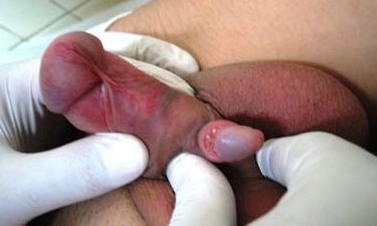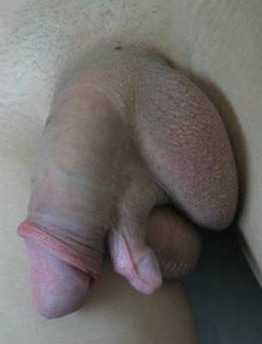Diphallia
Template:Search infobox Steven C. Campbell, M.D., Ph.D.
Overview
Diphallia, penile duplication (PD), diphallic terata, or diphallasparatus, is a medical condition in which a male infant is born with two penises. This is an extremely rare disorder with only approximately 100 cases of diphallia recorded since the first case reported by Johannes Jacob Wecker in 1609. Its occurrence is one in 5.5 million men in the United States.[1][2]
When diphallia is present, it is usually accompanied by other congenital anomalies such as renal, vertebral, hindgut or anorectal duplication. There is also a higher risk of spina bifida. Infants born with PD and its related conditions have a higher death rate from various infections associated with their more complex renal or colorectal systems.
It is thought diphallia occurs in the fetus between the 23rd and 25th days of gestation when an injury, chemical stress, or malfunctioning homeobox genes hamper proper function of the caudal cell mass of the fetal mesoderm as the urogenital sinus separates from the genital tubercle and rectum to form the penis.
Characteristics
- Those in possession of a diphallus tend to be sterile, due to either congenital defects or difficulties in application.
- Urine may be passed by both penises, by only one, or through some other aperture in the perineum.
- A range of duplication types have been seen, ranging from organs that fissure into two, to the presence of two distinct penises positioned at some distance from each other.
- Most diphalluses lie side by side and are of equal size, but they can be seated atop one another, with one distinctly larger than the other.
This rare condition has been documented in pigs and other mammals. It is commonly mistaken that all sharks have this condition, but in reality they have a pair of "claspers" which serve a reproductive function.
Diphallia is a medical condition and should not be confused with genital bisection, which is an elective procedure which involves the splitting of the penis.
Pathological Findings
Images shown below are courtesy of Geneva Foundation for Medical Education and Research and Marmara Medical Journal.
See also
References
- ↑ "Indian man wants op to remove extra organ". Reuters. Retrieved 2006-08-18.
- ↑ "Man wants op to remove extra organ". The Sydney Morning Herald. Retrieved 2006-08-18.
External Links

